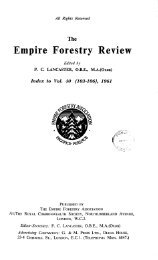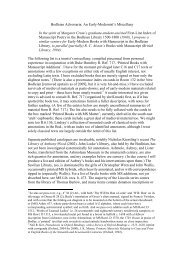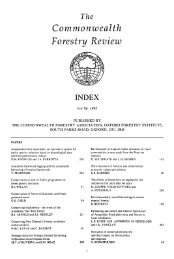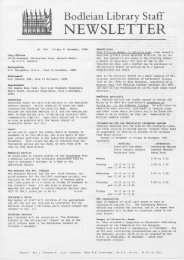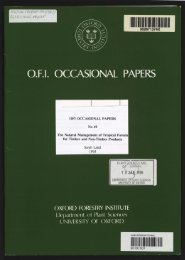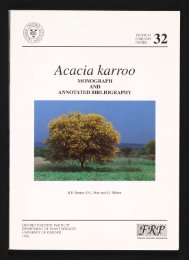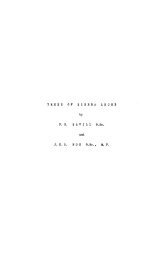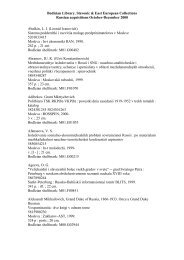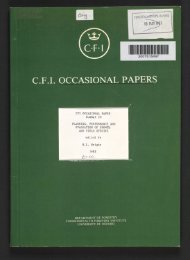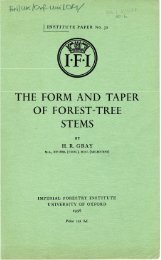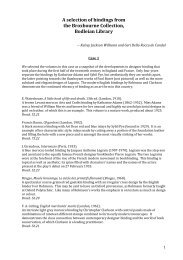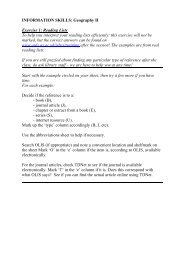Commonwealth Forestry Review
Commonwealth Forestry Review
Commonwealth Forestry Review
You also want an ePaper? Increase the reach of your titles
YUMPU automatically turns print PDFs into web optimized ePapers that Google loves.
42 COMMONWEALTH FORESTRY REVIEW<br />
contrasted with the mineral sediment from the streams after they had flowed through<br />
the logged and roaded area.<br />
The sediment graphs from the sampling stations located below logging activity<br />
shown in Fig. 3 show a peak early in the rise of the stream. This pattern was also<br />
characteristic of almost all the sampling in subsequent years and was probably due to<br />
the sediment source areas being fairly close to the sampling stations. The initial<br />
flush of surface runoff from bare areas in the lower portions of the catchment caused<br />
high sediment concentrations in the early stages of the stream rise. These high<br />
concentrations were diluted as the increased flows from the undisturbed upper catchment<br />
areas made their impact on the total flow. Sediment concentrations then increased<br />
again due' to stream bank and bed erosion from the high flows'.<br />
Samples were taken from one of the reservoirs in the city of Cairns nine hours after<br />
the main storm period which produced the sediment pattern shown in Fig. 3. These<br />
samples revealed a concentration of 430 p.p.m. The reservoir became fully charged<br />
with turbid water and took about a week to clear.<br />
Data from the permanent sampling stations provided information on the total<br />
sediment levels from the disturbed area of the catchment. However, 'it was necessary<br />
to pinpoint the sediment source areas and evaluate the contributions of the various<br />
sources. To achieve this, samples were collected from sections of the stream which<br />
were crossed by roads or were influenced by snig tracks, log ramps, etc. In some cases<br />
sediment source areas were located by following turbid water upstream during rain<br />
periods, until the source of the sediment was found.<br />
It became apparent that most of the sediment was derived from poorly located<br />
undrained roads and snig tracks and from earth and log fill crossings such as that<br />
shown in Fig. 4. One striking point which emerged was the fact that a major portion<br />
of the sediment was derived from a few small sediment source areas. An example of<br />
the effect of one of these areas is shown in Table 1. Even though no noticeable rise<br />
occurred in stream height, considerable sedimentation resulted.<br />
TABLE I<br />
Sediment concentration from a log ramp adjacent to the stream after rain influence of 26<br />
points in 20 minutes between 1320 and 1340 hours on 25.1.66.<br />
Upstream of ramp<br />
Location Time (hours) Sediment concentration (p.p.m.)<br />
Immediately downstream of ramp<br />
50 metres downstream of ramp<br />
400 metres downstream of ramp<br />
400 metres downstream of ramp<br />
13.45<br />
13.45<br />
13.50<br />
14.00<br />
15.45<br />
48<br />
2,602<br />
Table 1 shows also how the sediment clears rapidly once rain ceases. However,<br />
during the wet season light showers such as the one which caused the sediment levels<br />
shown in Table 1 frequently occur for days or even weeks at a time. Consequently<br />
this can result in an almost continuous source of sediment-laden water leaving the<br />
catchment.<br />
In general, sedimentation occurred following almost every rain influence and it<br />
became severe and affected the city water supply after rains ofmoderately low intensity.<br />
The area covered by snig tracks during normal rainforest logging is considerable<br />
as can be seen from Table 2. '<br />
203<br />
186<br />
21



